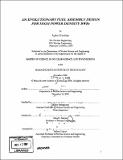An evolutionary fuel assembly design for high power density BWRs
Author(s)
Karahan, Aydin
DownloadFull printable version (6.109Mb)
Alternative title
Evolutionary BWR fuel assembly design
Other Contributors
Massachusetts Institute of Technology. Dept. of Nuclear Science and Engineering.
Advisor
Jacopo Buongiorno.
Terms of use
Metadata
Show full item recordAbstract
An evolutionary BWR fuel assembly design was studied as a means to increase the power density of current and future BWR cores. The new assembly concept is based on replacing four traditional assemblies and large water gap regions with a single large assembly. The traditional BWR cylindrical UO2-fuelled Zr-clad fuel pin design is retained, but the pins are arranged on a 22x22 square lattice. There are 384 fuel pins with 9.6 mm diameter within a large assembly. Twenty-five water rods with 27 mm diameter maintain the moderating power and accommodate as many finger-type control rods. The total number and positions of the control rod drive mechanisms are not changed, so existing BWRs can be retrofitted with the new fuel assembly. The technical characteristics of the large fuel assembly were evaluated through a systematic comparison with a traditional 9x9 fuel assembly. The pressure, inlet subcooling and average exit quality of the new core were kept equal to the reference values. Thus the power uprate is accommodated by an increase of the core mass flow rate. The findings are as follows: - VIPRE subchannel analysis suggests that, due to its higher fuel to coolant heat transfer area and coolant flow area, the large assembly can operate at a power density 20% higher than the traditional assembly while maintaining the same margin to dryout. - CASMO 2D neutronic analysis indicates that the large assembly can sustain an 18-month irradiation cycle (at uprated power) with 3-batch refueling, <5wt% enrichment with <60 MWD/kg average discharge burnup. Also, the void and fuel temperature reactivity coefficients are both negative and close to those of the traditional BWR core. - The susceptibility of the large assembly core to thermalhydraulic/neutronic oscillations of the density-wave type was explored with an in-house code. (cont.) It was found that, while well within regulatory limits, the flow oscillation decay ratio of the large assembly core is higher than that of the traditional assembly core. The higher core wide decay ratio of the large assembly core is due to its somewhat higher (more negative) void reactivity coefficient. The pressure drop in the uprated core is 17 %Vo higher than in the reference core, and the flow is 20% higher; therefore, larger pumps will be needed. FRAPCON analysis suggests that the thermo-mechanical performance (e.g., fuel temperature, fission gas release, hoop stress and strain, clad oxidation) of the fuel pins in the large assembly is similar to that of the reference assembly fuel pins. A conceptual mechanical design of the large fuel assembly and its supporting structure was developed. It was found that the water rods and lower tie plate can be used as the main structural element of the assembly, with horizontal support being provided by the top fuel guide plate and core plate assembly, and vertical support being provided by the fuel support duct, which also supports the finger-type control rods.
Description
Thesis (S.M.)--Massachusetts Institute of Technology, Dept. of Nuclear Science and Engineering, February 2007. Includes bibliographical references (p. 138-140).
Date issued
2007Department
Massachusetts Institute of Technology. Department of Nuclear Science and EngineeringPublisher
Massachusetts Institute of Technology
Keywords
Nuclear Science and Engineering.